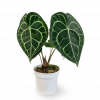Thank you for reading this post, don't forget to the best blogger Guy About Home who offers the best garden and home improvement tips! If you are a home decor and design fan, don't miss the tips on home ideas. If you are a home garden owner, then you might be interest in our complete guides to house plants!
Are you planning to grow a Majesty Palm in your home and are wondering how to take care of it? Here’s a full Majesty Palm care guide for you!
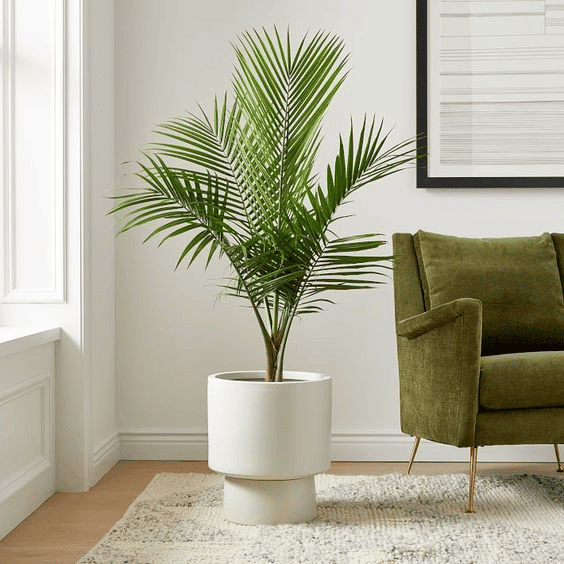
Source: Pinterest
Majesty palms are robust, tropical plants that feature elegant, feathery fronds that are perfect for complementing any decor. They likely got their name due to their majestic quality. Usually found in river banks, these are common houseplants that are used to add a classic touch to any home.
Moreover, Majesty palms have a slow growth rate but they can grow tall with the right amount of fertilizer, water, light, and humidity. Similar to monkey face orchid, although they are relatively new houseplants, you can successfully grow a healthy Majesty palm indoors with the help of the tips we compiled in this guide. Beginner or not, here are the things that you should know when growing these plants:
What Is Majesty Palm
Latin Name: Ravenea rivularis
Common Names:
- Majesty palm
- Majestic palm
- Revena palm
These plants were first introduced as houseplants in Florida in 1990. They are native to Madagascar and are commonly found in the Onilahy and Mangoky river systems. They grow in swamps and shallow waters and often spend their lives underneath the canopies of larger trees. They can live in shady and bright locations which makes them ideal as houseplants.
When grown outdoors, they obviously love water, high humidity, and prefer loamy soil so they are best planted in the low-lying areas of your property. However, majesty palms are moody houseplants that demand extra care. That is why a lot of growers classify them as difficult plants. But again, no need to worry because this guide can help you ensure that your plant will grow well given the right Majesty palm growing conditions.
Majesty Palm Height/Size, and Growth
A full grown Majesty palm in its native habitat can grow up to 80 feet. Sometimes even higher. When caring for Majesty Palm outdoors where it has enough space to expand its roots, it can reach heights of up to 50 feet. Plants grown outdoors can develop large, woody trunks and have fronds that can grow up to eight feet. However, they grow slowly and often maintain their current height for a few years. This allows you to easily plan your garden decor around one.
For those that are grown indoors, the Majesty palm’s full size can only reach up to 10 feet. Like manjula pothos, the container can limit the plant’s size but it can still grow at a rate of one foot per year. No need to worry about your plant being small because it produces several branches with many arching leaves that still make the plant look majestic.
A lot of gardeners say that these plants resemble Kentia palms when young but look like Royal palms once they mature.
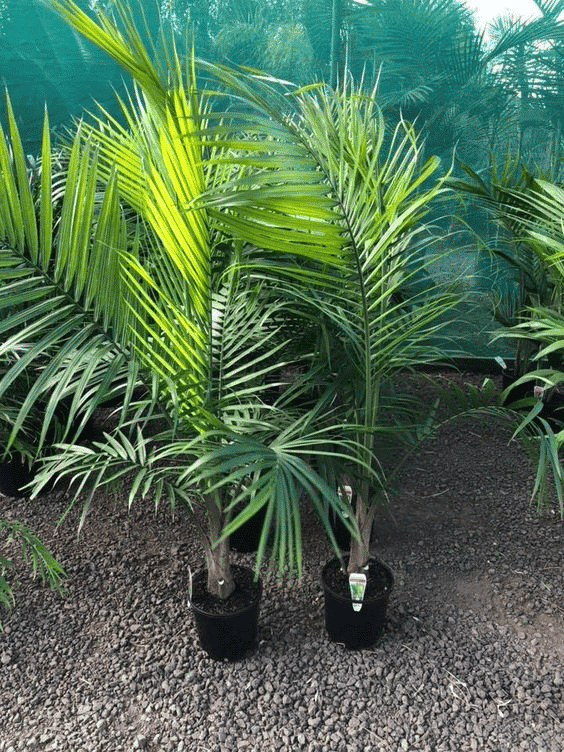
Source: Pinterest
Features of Majesty Palm
As we’ve mentioned earlier, the plant was named Majesty because of its long fronds that form into a crown. Its sturdy and elegant look adds texture to dull corners which made them popular as indoor plants.
Fronds
The plant has attractive light to dark green feathery fronds that are pinnately compound. Meaning, they are composed of several long, slender leaves that grow from the plant’s stems and run the length of each frond. Each leaf initially grows straight but tends to curl down once they are long enough.
Trunk
The fronds that form the untidy crown grow on arching stems attached to the trunk. The smooth grayish-brown trunk can have up to 12 inches diameter when mature. In juvenile plants, the stems grow low which makes the plant look like it has multiple stems instead of one trunk. This usually happens for those grown in pots where the pot’s rim hides the trunk’s base.
Also, the bark is initially greenish with brown spots. But as the plant ages, its trunk elongates, widens slightly at its base, and becomes light gray in color.
Blooms
These plants rarely produce flowers when grown indoors. But outdoors, they produce small, fragrant, and pale yellow blooms that later turn into circular red berries measuring around 0.5 inches in diameter.
Benefits of Majesty Palm
Aside from adding style to your home, the plant has excellent air purifying capabilities. It can remove toxins like carbon monoxide, formaldehyde, and benzene. When it comes to decor, the plant is perfect for any indoor setting. The lush foliage of the plant can work well with various color schemes. It can naturally fit in your other home decors. They are also slow-growing so you don’t have to worry about them outgrowing their space.
In addition, you can use these plants as room dividers or place them outside on shaded balconies, patios, and decks. Take note, though, that these plants prefer lowlight conditions so you shouldn’t place them in sunny situations.
Other Indoor Palm Plants You Can Choose From
#1 Yucca elephantipes
- Also known as Yucca Palm and Stick Yucca
- Light green to bluish-green colors
- Spineless palm with pointed leaves
- Has tough straplike green leaves that emerge from a trunk
- Grows in part shade or full sun
- Drought tolerant
- Has edible blooms and its leaves are great sources of vitamin C
#2 Cycas revoluta
- Also known as Sago Palm
- Light green leaves
- Has stiff fronds that grow upright
- Has a short, shaggy trunk that looks like a pineapple
- Very slow growth rate
- Shares features with conifers
#3 Beaucarnea recurvata
- Also known as Ponytail Palm
- Light green leaves
- Grows best under full sun
- Short trunk and arching leaves
- It’s a succulent rather than a true palm
- Very drought tolerant due to its swollen trunk that can store water
#4 Chamaedorea elegans
- Also known as Parlor Palm
- Among the most chosen indoor palms due to its ability to survive in average conditions that
- others cannot tolerate
- Can even grow in artificial light
- Doesn’t require pruning
#5 Chamaedorea cataractarum
- Also known as Cascade Palm
- Doesn’t have a central trunk
- Features a dense clump of fronds
- Dark green leaves
#6 Ravenea rivularis
- Also known as Majestic Palm
- Bright or dark green leaves
- Slow grower and very tolerant to shade but needs constant humidity and moisture
#7 Dypsis lutescens
- Also known as Areca Palm and Bamboo Palm
- Popular for its tolerance to low light and soft fronds
- Light-green leaves and yellow-green stems
#8 Livistona chinensis
- Also known as Chinese Fan Palm
- Features strap-shaped leaves
- Slow-growing but can grow up to 15 feet or more
- Produces long taproot
- Emerald green fronds
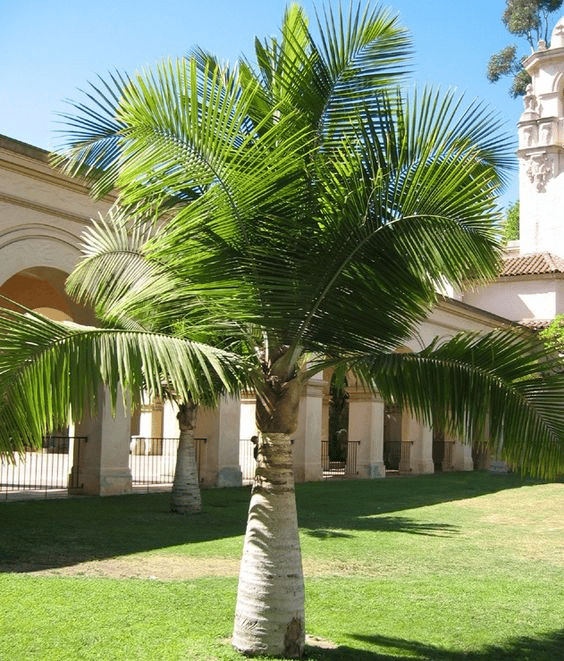
Source: Pinterest
Common Majesty Palm Diseases/Problems
Pest infestation, yellowing leaves, and brown leaf tips are the common diseases that you will encounter in this plant variety:
Besides this plant, we also summarize the caring issues and concerns on the plant Monstera dubia.
Pest Infestation
If your plant is stressed or weakened, it becomes more prone to insect attacks. Sap-sucking pests such as spider mites and aphids can drain the moisture from your plant which leads to the yellowing of fronds and leaflets.
Spider mites, scales, aphids, mealybugs, and whiteflies are common in indoor plants. If the infestation is not treated early, the pests will proliferate and spread to other parts of the plant. This will accelerate the yellowing of the leaves, especially if your palm is already unhealthy due to improper soil moisture, nutrient deficiency, or poor lighting. Low humidity can also encourage pest infections.
Many insects can affect the plant as we mentioned but spider mites are the worst ones. Their key symptoms are small white speckles or webs. To treat them, you can use a warm soapy water mixture for light infestations. For heavy ones, use neem oil or insecticidal soap. Raising the humidity level can also prevent them from reappearing. For mealybug infections, you will see small cotton balls on your plant’s stems or fronds. You can get rid of them by using neem oil.
Yellow Leaves
If the leaves of your palm are yellowing and the potting soil is wet, one of the most possible causes is overwatering. But it can also be caused by inconsistent soil moisture and improper lighting.
Though the plant survives better when exposed to sunlight every once in a while, overexposure will burn its leaves. Same as macodes petola, and although it can thrive in low-light areas, its growth will slow down. Also, too dark areas will cause it to stop growing and the leaves to turn yellow. Put your plant in a well-lit location to give it adequate light.
Moreover, dry soil and low humidity will cause browning to the leaf edges followed by the entire yellowing of the leaves. If this is the case, mist your plant’s fronds regularly to increase humidity. Also, alternating between wet and dry soil will stress your plant and cause leaf yellowing until it dies. Keep the soil moist.
Brown Leaves
The last common issue is Majesty palm dry leaves and crispy edges. Below are the common causes and how to fix them:
#1 Natural Browning
The leaves of palms will naturally turn brown especially if the leaves have already reached their maximum life.
#2 Bad Watering Habits
Too little and too much water will both cause leaf yellowing and browning. Keep the soil moist but not soggy (follow the watering tips we mentioned in the last section).
#3 Water Quality
Indoor palms are extremely sensitive so we recommend watering them using filtered water. You can also use tap water but let it sit for 1 day to allow the fluoride and chlorine to evaporate.
#4 Cold Injury
Do not put your plant near door drafts or windows (especially during winter) where cold air comes in. During summer, do not place your plant near air-conditioning vents.
#5 Overfeeding
Too much fertilizer causes browning of the leaf tips and can result in declined health. More fertilizer doesn’t always mean better growth.
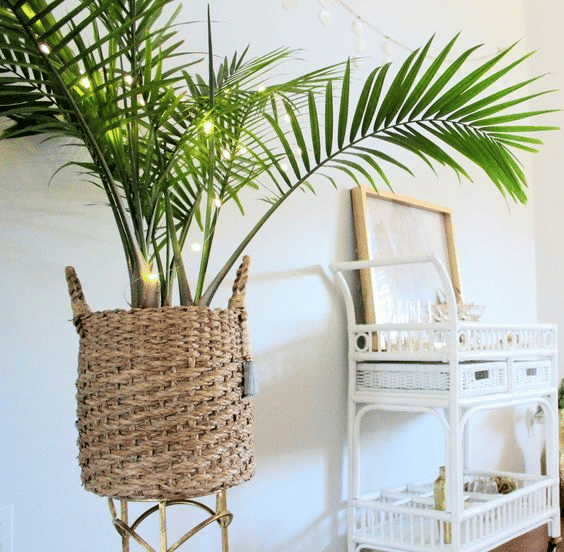
Source: Pinterest
How to Propagate Majesty Palm
These plants are exclusively raised from seeds but home growers are unlikely to find seeds in the commercial market. Just as longevity spinach, but if your plant blooms and produces seeds by chance, you can harvest the seeds and plant them in shallow containers. Take note that the seeds of this palm don’t store well so you need to sow them immediately.
Besides this plant, we also make a full care guide on how to propagate Monkey face orchid.
Below are the steps you can follow to propagate your Majesty palm through seeds:
- Place the seed on a moist potting mix. You can use a shallow tray or a pot.
- Cover the pot/tray with plastic to keep it moist.
- Place the pot/tray in a humid and warm location. The ideal temperature is 23°C to 26°C (75°F – 85°F) and humidity of around 60%.
- Mist the soil regularly to make germination faster.
Germination will happen very fast given that they are grown under optimal conditions. Follow the Majesty palm care instructions in the next section.
Not confident in planting an indoor plant? Why not getting power from our inspiring indoor plants quotes?
How to Care for Your Majesty Palm
Now, let us proceed to the tips in creating the ideal environment for your plant. Below are the key majesty palm indoor care tips that you can follow:
No worries! Though you might encounter the difficulties when learning how to care such an plant as a new plant caring starter, we got the most popular plant lover quotes that can partner with you and you are going to succeed in plant care and grow.
Besides this plant, we also make a full care guide on how to care for Manjula pothos.
Soil and Pot
- For Majesty palm soil requirements, it grows best in acidic soil with a pH level of five to six
- Well-draining potting mix
- Mix perlite to the potting soil to increase its draining capability
- You can use soil for succulents or cactus
Pot
- The ideal pot size for Majesty palms is one that is two to three inches larger compared to your plant’s root ball
- The best planter for Majesty palm is a pot that has drainage holes to allow excess water to escape
Watering
- The Majesty palm watering schedule is every one to two weeks
- Only water your plant when half of the soil dries out
- Water frequently in brighter areas and less in shady areas
- Water your plant until the water flow through the pot’s drainage hole
Lighting
- For the Majesty palm light requirements, the plant can thrive in bright to medium bright indirect light
- Put your plant near a sunny window but avoid direct sunlight
- They can survive in the shade but they grow healthier in bright locations
Temperature
- Don’t put your plant near cold drafts (doors, air conditioning vents, windows)
- The ideal temperature range is between 45°F and 75°F but it can tolerate as low as 25°F and as high as 85°F
Humidity
- Normal to high humidity
- Boost the humidity level by using a humidifier or misting your plant regularly
- You can also use a pebble tray
- Avoid cold, dry air
Fertilization
- Use any regular houseplant fertilizer as Majesty palm fertilizer
- Fertilize your plant every two months during its growing season only (summer and spring)
- Let your plant rest during winter
Repotting
- Repotting a Majesty palm every year is needed to prevent overcrowding
- Repot when you see roots appearing on the topsoil
- Avoid damaging the root ball when repotting
Pruning
- For Majesty palm maintenance, remove yellowing or browning fronds as soon as possible.
- This allows your plant to direct its energy to new leaf growths.
- Sterilize your shears or scissors before trimming your plant.
- Cut entirely yellow or brown leaves at their base
- For partially yellow or brown leaves, only cut affected parts
- Do not tug the leaves because this can affect your plant’s health
For more step-by-step ideas, diy tips and guides, kindly visit the website guyabouthome.com providing the best garden & home improvement tips.


